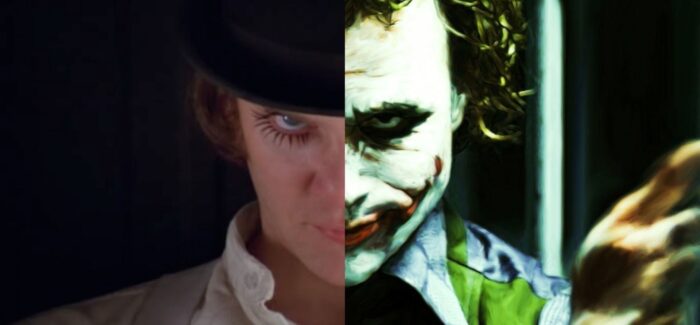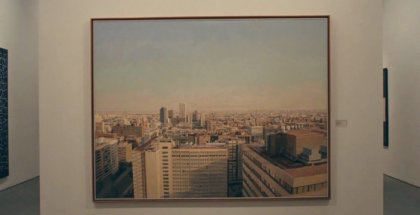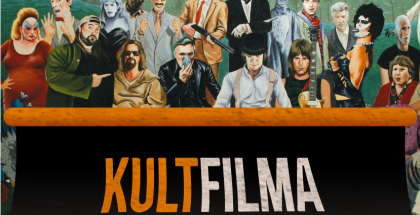Clockwork Orange vs. Joker: Violence in Cinema Reflecting the Violence in Real Life
“Well, well, well… All I have are negative thoughts”… it is with these combined symbolic phrases from both films that I would like to begin this take, in which I will observe and provide insights on the representation of violence in the cult-movies Clockwork Orange (1971) and Joker (2019). Through comparative analysis, I will attempt to explain the emotions they revoke in the viewer and the possible interpretations, including the political implications and the psycho-sociological realities of their representation, as well as the influence they exert. These two punchlines, acting as ‘supersigns’, are somehow able to describe the general moods in both films and of their main protagonists. As it will be observed, while they are both labeled as violent and put in the same basket, in many aspects they maintain fundamental differences. Furthermore, I will suggest a possible perspective for understanding the ‘bigger picture’ involved in the process of the creation, reception and reproduction of film content, including violent ones.
To begin with, I would like to establish the way we understand the generally applied factor of ‘emotion in cinema’, in order to increase the effect it exercises on the public. Affecting emotion through films is a crucial factor for the public to be integrated and taken into the experience of the moving image and the story that it wishes to tell (Glapka, 2019). Violence in the movies is one of the most common methods of achieving affection in the public. Through the screening of violence, we are in direct contact with the physical implications of the cinema. The intensity of violence and the extent of its explicit exposure are in a forthright relation with the intensity of effects it exerts on the audience, and there seems to be no stronger compelling pull inwards as the one through the exposure of physical violence. Moreover, the exposure of more explicit violence evokes powerful responses and is therefore able to create a more straightforward communication with the public for the purpose of ‘dragging them’ into the story. Accordingly, the horror, fear, pain, disgust, all of these emotions interact in the process of reception, inciting revengeful responses and the search for a relief from the hardships. Aside from that, and especially in the Joker movie, we see a central non-physical exertion of violence and abuse. On the other hand, in Clockwork Orange, the psychological violence (and therefore emotional too) is exposed on a different plane: the ‘State’ against the individual, or Alex against the society. However, the main character never fully gives into it, and although after his forced and artificial trial into feeling remorse, he is both physically and psycho-emotionally abused. The outcome, without providing any clear evidence for it, shows us that violence can also be an innate tendency without a purpose in itself. We only notice in some rare cases, as is the moment of meeting his parents and their new flat resident, that Alex is able to feel some particular form of sadness, but after the failed suicide attempt, when his natural state is reset, we are reminded that he remains the original youngster genuinely prone to evil.
The way Clockwork Orange structures the violent acts, the emotions involved in committing them and the forms in which the retaliation is carried out seems transparent. It is rather meaningless; violence for the sake of violence, and it is perhaps these types of interpretations that give rise to the critiques of describing the film as an ode to the senseless violence. However, – being familiar with his oeuvre – Kubrick, as usual, seems to have been mostly interested in the conceptual and technical aspects of cinematographic details, focusing more conceptually and technically from the cinematographic point of view, and was not much concerned about the semantization of the story. However, the one in charge of this detail, the creator of the novel that the film is based on, Anthony Burgess, was not satisfied with the extent of the violence in the film adaptation of his novel, because the story for him is personal and reflects the violent experience that was inflicted upon his wife, in a tragic incident (Manser, 2020). Kubric’s decision to prioritize the cinematographic technical and conceptual aspects rather than the narrative conception itself, could alternatively be viewed as a possibility to create what Umberto Eco calls open works (Eco, 1989), in which an interactive response from the audience is required to complete the work. This also helps the story to achieve a high level of mystification by being hard to deconstruct in the regular ways that the public is used to in dealing with standard narratives.
The Joker, however, has a more easily graspable order of events. The difference seems to be that the journey of the protagonist starts in the form of the bottom-up evolution. The violence on him (both psycho-emotional and, as we later learn, physical too) starts from the early scenes, and later transforms into a reversed revenge violence. On the other hand, Alex starts as a hedonistic ‘violent lad’, without additional evident purpose for applying that much violence. He later submits to the exertion of violence – both physical and psycho-emotional – on him by the state and society. The violence in Clockwork Orange has an emphasis on a gendered base fixation, in which even in the act of abuse, while receiving it the male is left as a powerless spectator, while the women are both sexually abused (physical or psycho-emotional abuse). This has further moral implications, which when watching the film requires our empathy in feeling the gender-based violence (Christiansen, 2016). However, in the end, after the suicide attempt, with an unexplainable turn of events – perhaps by ‘divine’ providence – he is able to acclaim his natural state of mind. To the contrary, the Joker story seeks ways to justify the later violent response – the murders, preparing the public for it, by employing constant psycho-emotional abuse on the main character by his surroundings. On the ‘standard’ viewer, these provocations can create aversion, but also prompt emotions of sympathizing with him as the victim of societal abuse and a failing system. Through this, his later transformation into a ‘killer’ – always expressed in morally justifiable murders – is seen as a normal individual response to the society as a whole, and to each separate case distinctively. Although the movie clearly tries to distance the main character’s act from having political motivations, as in the case of his public interview appearance scene in his favorite show, Arthur subtly and jokingly speaks of his story in the context of his relationship with the society and the state, when he says: “What do you get when you cross a mentally ill loner with a society that abandons him and treats him like trash? You get what you f**king deserve”. He then proceeds to shoot the -until then favorite- show host. This act is clearly felt by the alleged group of people he unintentionally represents, as it can be interpreted by the massive response his violent acts get in the streets and the demonstrations they inspire. Such supportive reactions inside the film are a form of affecting viewers’ emotions and the possible reactions, in which one is led to face the decision if it is the right thing to do in supporting the uprising. The public response to the violent and criminal acts committed by the protagonist and his droogs in Clockwork Orange seem rather reserved, calculated, or used for the daily tit-for-tats inside the political rivalries. No matter how unjustifiable the violent acts of the gang are, when put in the political and social context, the public is forced to experience a calculated retreat in interpreting them. More so, a sympathy is awakened in response when the group (society/state) revenge is performed on the individual, who in his sincere inclination to evilness is seen as a naïve victim, while his cunning droogs are spared.
Celebrating violence or channeling reality
In both cases, the public responses have been diverse, where a good part comes in the form of criticizing the movies as irresponsibly celebrating violence, such as the example of the accusations from families of the victims in violent mass shooting terror acts in the United States (Manser, 2020). The ‘defenders’ on the other hand, aside from the normalized types of justifications of artistic production liberties, have gone as far as to seeing the screened violence as a necessary response to the ever-present violence in real life. The ways in which these two films represent violence are clearly not the same. This could be attributed to many external factors, but the most important are the political and timing context. The most recent one (Joker, 2019) happened to be premiered just some months prior to the beginning of Presidential election campaign in the US (2020), and was followed by the massive Protests following the police murder of George Floyd (May, 2020). This climate, along with the emerging pandemic, additionally complicated and hyped up the reception of the story of Joker. Clockwork Orange holds a different cult history, seemingly a dominantly European one, where various youth gangs in the 70s and 80s drew inspiration from the ultra violence in the movie, as a form of dissent against the system. It even reached football ultras and hooligan cultures with many collectives drawing direct identification with the movie characters and scenes. Such is the case of the famous Ultras group of Juventus football club in Italy called “Drughi” in reference to the Russian origin slang language used for “friends” in the film. Moreover, the group logo is also extracted from one of the scenes in the movie. The violence in these circles (ultras and hooligan cultures) was seen as an integral part of their culture, a way of life. The performance of violence was not directly related or seen as a form of response to the state regarding their political status (although this detail was in no case unaffected); to the contrary, they found a public justification for their own genuine need for physical violence. And since the need is there, it is rather easy to invent different individual or collective pretexts for engaging in it. It is exactly this interpretation that provides a hint for understanding why these types of conceptualized – but also in cases meaningless – violent productions trigger massive response. However, experiencing the violence in one’s own flesh is not the only way to engage with it. There exist different forms of voyeurism in relation to violence, and the one displayed on screen is not an exemption. The passive experience of violence on screen in some cases might evoke emotional responses due to the active non-physical violence experienced in real life. This could be a psychological explanation to the massive appeal that both productions have reached, aside from being charged with direct accusation of promotion and celebration of violence. Further Political and Socio-psychological implications To understand the reception, responses, and the influence that certain filmic productions utilize on the masses is rather an anthropological task. Since the advent of modern technology (and by that I imply the beginning of the 20th century), the way most of western societies function, produce, recycle and interpret has undergone an intense period of dynamic innovations. These changes in the social fabric have direct implications on the creation and reception of narratives. The progressive evolution of the cinema gave rise to the phenomenon of exhaustion of themes and stories, so the filmographer rightly turned towards more aesthetic and artistic filmic productions to make up for it. However, the way globalization has shaped the world ever since, requires the filmic productions to meet their economic end, and so this mishmash of aesthetics, economics, and mainstream culture values is what shapes the content and extent of anything represented in movies today. Therefore, if we see a ‘violence for the sake of violence’ being spread (Clockwork Orange), it means that it fits the culturally spatiotemporal context.
Similar situation is the case when we see the exposure of a justified explicit violence as in the semanticized story of Joker, loaded with different cultural and artistic contexts (the comic-book series, graphic novel, Batman movie series, etc.) (Collins, 2019). Both represent references that expose anthropological truths and facts of the societies concerned, and in both cases it’s those of the neoliberal English-speaking dominated global society. The moment of differentiation between the two opposing groups (the poor versus the rich), as is the case in the story of Joker, brings to life the divide in the society. This dilemma of ‘methodological representation’, in the words of J.F. Lyotard stands in the possibilities of defining the western civilization either as a unitary whole or through the Marxist interpretation of class division (Lyotard, 1984). Although, back when his theory was constructed, it was strictly in reference to the developed countries of the west, today, more than ever, this reality could be interpreted as a relevant situation affecting almost the whole world. The personality of the Joker, usually seen through the antagonist prism in previous episodes, arises as the voice and the retaliation of the oppressed class of the fictional – but generic American – Gotham city, able to incite a class revolution on the streets. We see acts of thievery, killings, and demolition portrayed as a monumental achievement accompanied by hypnotic euphoric non-diegetic score, to include the external world inside the story (Laine, 2011). These and the rest of similar modes of representation of violence leave open the possibility for the film to be interpreted as celebrating violence, but one filled with politically charged meanings.
Few concluding remarks
To know a culture is to know its myths. There exists an understanding that myths and mythical content hold the overall philosophy of an epoch and its cultural elements – the zeitgeist of a period. It could be interpreted that they are the conjunction of what an epoch could be defined with. Today, film is the dominant epitome for transmitting mythical narration, leaving other mediums and genres far behind. It is as if the cinema came up to become the conventional channel for mythical production, measurement and debasement. The general question of whether film imitates life or – as film evolved – life imitates film is irrelevant and of circular logic. Therefore, we could agree that it comes in an interwoven relationship package, which needs to be acknowledged for its importance and for what it holds for us. In studying the content and reception of filmic productions, especially those that exercise major influence because of their critical time- and culture relevant ‘grabs’ of the moment (times’ spirit) – despite the marketing implications – we can identify the truths about the socio-political and psychological realities that give birth and sustain these films (therefore myths). The source of myth is the collective hybrid mind (Donald, 2001). In this understanding, it is not of much importance whether Stanley Kubrick or Todd Philips produced it, rather it is seen as a production of a collective hybrid mind that delivers impulses to its external part and as such, it gets impulses back – in our case the general appeal in the public. More specifically, this phenomenon of impersonal attribution can be seen in the case of Stanley Kubrick, who was mostly interested in creating a cinematographic masterpiece before anything else. The violence we see on the screen is a reflection of the violence of the systems and societies we live in.
We reproduce this violence through the use of our modes of narrative representation in different media, with cinema dominating the space. This is a process of channeling and refueling the emotions that are complementarily triggered. They have reached a point where we can no longer tell if the source is life or film. The process of emitting these emotions to the channel of production, and from there right back to the society is in itself a
process of interactive affective discourse which keeps its order through its uncontrollable and independent existence.
As it seems, violence then represents a unique form of lingua franca for establishing communication and maintaining relations (Dever, 1989). In the films, it appeals to our emotions and drags us into the story for many of the reasons stated above, such as fear, horror, feeling represented, and various other needs related to it or other fetishist desires that incite emotional interaction.
References:
Christiansen, S. L. (2016). Pain and the Cinesthetic Subject in Black Swan. Screen Bodies, 1(2), 25-41.
Eco, U. (1989). The open work. Harvard University Press.
Dever, M. (1989). Violence as lingua franca: Keri Hulme’s the bone people. Journal of Postcolonial Writing, 29(2), 23-35.
Donald, M. (2001). A mind so rare: The evolution of human consciousness. New York: Norton & Company.
Glapka, E. (2019). Critical affect studies: on applying discourse analysis in research on affect, body and power. Discourse & Society, 30(6), 600-621
Laine, T. (2011). Imprisoned in Disgust: Roman Polanski’s Repulsion. Film-Philosophy, 15(2), 36-50.
Lyotard, J. F. (1984). The postmodern condition: A report on knowledge (Vol. 10). U of Minnesota Press.
Wetherell, M. (2013). Affect and discourse–What’s the problem? From affect as excess to affective/discursive practice. Subjectivity, 6(4), 349-368.
Collins, S. T. (2019). The Complete History of the Joker. RollingStone.
https://www.rollingstone.com/movies/movie-features/complete-history-of-the-joker-889033/
Lawson R. (2019). Joker Review: Joaquin Phoenix Towers in a Deeply Troubling Origin Story.
https://www.vanityfair.com/hollywood/2019/08/joker-review-joaquin-phoenix
Manser M. (2020). A Clockwork Clown: Sex and violence on screen. Artefact Magazine.
https://www.artefactmagazine.com/2020/01/28/the-clockwork-clown/
Bhosle V. (2021). ‘A Clockwork Orange’ and its Political Relevance Today. FrameRated. Medium.
https://medium.com/framerated/a-clockwork-orange-and-its-political-relevance-today-b45542ce4e2b
*Marrja e përmbajtjeve të plota apo pjesore të artikujve lejohet vetëm me shtimin e referencës për postimin origjinal në blog.



















